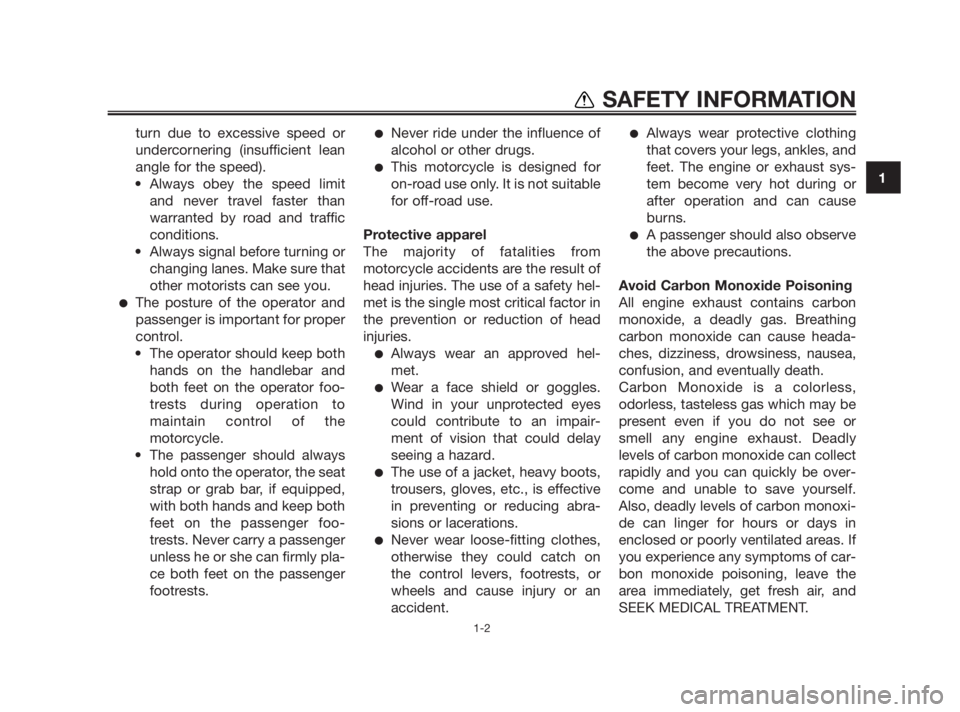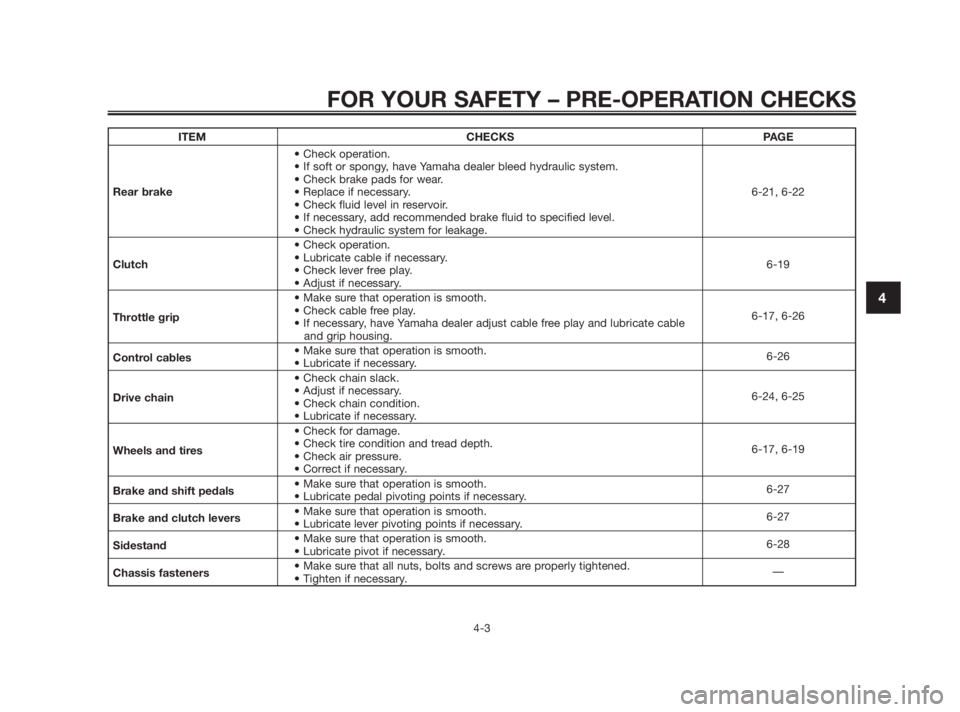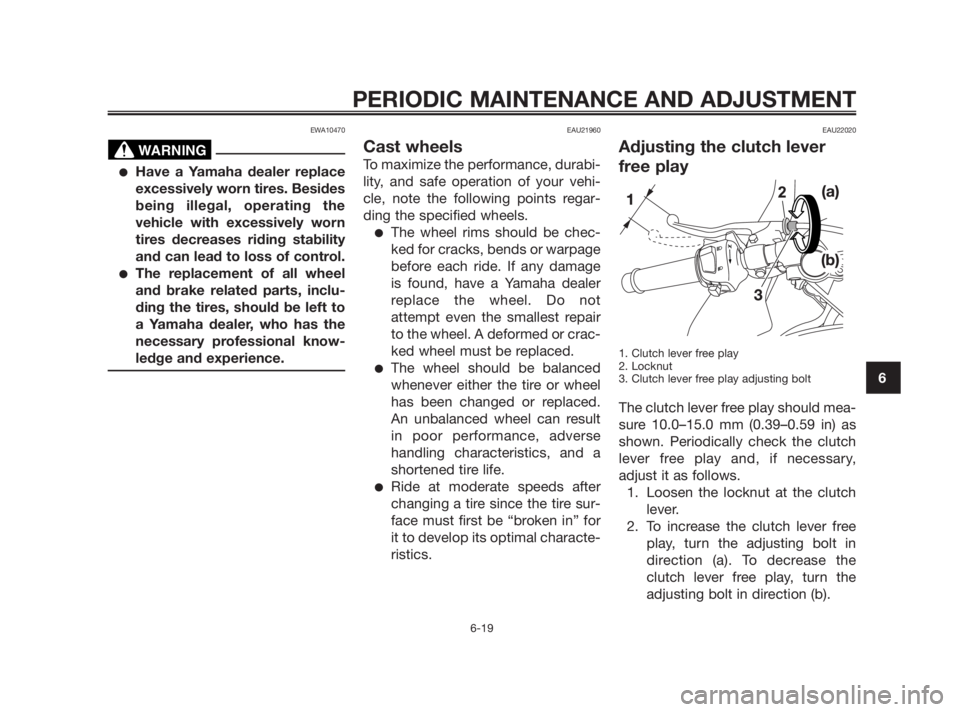2011 YAMAHA TZR50 wheel
[x] Cancel search: wheelPage 6 of 88

SAFETY INFORMATION .....................1-1
DESCRIPTION.....................................2-1
Left view ...........................................2-1
Right view .........................................2-2
Controls and instruments .................2-3
INSTRUMENT AND CONTROL
FUNCTIONS ........................................3-1
Main switch/steering lock .................3-1
Indicator and warning lights .............3-2
Turn signal indicator light ................3-2
Neutral indicator light ......................3-2
Oil level warning light ......................3-2
Coolant temperature warning light ..3-3
Engine trouble warning light ............3-3
Speedometer unit .............................3-3
Tachometer .......................................3-4
Handlebar switches ..........................3-4
Pass switch ......................................3-4
Dimmer switch .................................3-4
Turn signal switch ............................3-4
Horn switch .....................................3-4
Engine stop switch ..........................3-5
Start switch ......................................3-5
Clutch lever .......................................3-5
Shift pedal.........................................3-5
Brake lever ........................................3-6
Brake pedal.......................................3-6
Fuel tank cap ....................................3-6
Fuel ...................................................3-7Fuel tank breather/overflow hose .....3-8
Catalytic converter............................3-9
2-stroke engine oil ............................3-9
Fuel cock ........................................3-10
Starter (choke) lever ......................3-11
Seat.................................................3-11
Anti-theft device housing................3-12
Rear view mirrors ............................3-12
Sidestand ........................................3-13
Ignition circuit cut-off system .........3-13
FOR YOUR SAFETY –
PRE-OPERATION CHECKS ...............4-1
Pre-operation check list....................4-2
OPERATION AND IMPORTANT
RIDING POINTS ..................................5-1
Starting a cold engine ......................5-1
Starting a warm engine ....................5-2
Shifting ..............................................5-2
Tips for reducing fuel
consumption..................................5-3
Engine break-in.................................5-3
Parking ..............................................5-4
PERIODIC MAINTENANCE AND
ADJUSTMENT ....................................6-1
Owner’s tool kit .................................6-1
Periodic maintenance chart for the
emission control system ...............6-3General maintenance and lubrication
chart ..............................................6-4
Removing and installing cowlings
and panels .....................................6-8
Checking the spark plug ................6-10
Transmission oil ..............................6-11
Coolant ...........................................6-13
Air filter element ..............................6-15
Adjusting the carburetor .................6-16
Adjusting the engine idling speed ..6-16
Adjusting the throttle cable free
play ..............................................6-17
Tires ................................................6-17
Cast wheels ....................................6-19
Adjusting the clutch lever free
play ..............................................6-19
Checking the front brake lever free
play ..............................................6-20
Adjusting the brake pedal free
play ..............................................6-20
Adjusting the shift pedal position ...6-21
Adjusting the rear brake light
switch ..........................................6-21
Checking the front and rear brake
pads.............................................6-21
Checking the brake fluid level ........6-22
Changing the brake fluid ................6-23
Drive chain slack.............................6-24
Cleaning and lubricating the drive
chain ............................................6-25
TABLE OF CONTENTS
5WX-F819D-E3 15/11/08 15:27 Página 6
Page 7 of 88

Checking and lubricating the
cables ..........................................6-26
Checking and lubricating the throttle
grip and cable .............................6-26
Adjusting the Autolube pump .........6-27
Checking and lubricating the brake
and shift pedals ...........................6-27
Checking and lubricating the brake
and clutch levers .........................6-27
Checking and lubricating the
sidestand .....................................6-28
Checking the front fork ...................6-28
Checking the steering.....................6-29
Checking the wheel bearings .........6-30
Battery ............................................6-30
Replacing the fuse ..........................6-31
Replacing the headlight bulb..........6-32
Replacing the tail/brake light
bulb .............................................6-33
Replacing a front turn signal light
bulb .............................................6-34
Replacing a rear turn signal light
bulb .............................................6-34
Replacing the license plate light
bulb .............................................6-35
Troubleshooting ..............................6-36
Troubleshooting charts ...................6-37
MOTORCYCLE CARE AND
STORAGE ............................................7-1
Matte color caution...........................7-1Care ..................................................7-1
Storage .............................................7-3
SPECIFICATIONS ...............................8-1
CONSUMER INFORMATION .............9-1
Identification numbers ......................9-1
Key identification number .................9-1
Vehicle identification number............9-1
Model label .......................................9-2
TABLE OF CONTENTS
5WX-F819D-E3 15/11/08 15:27 Página 7
Page 9 of 88

turn due to excessive speed or
undercornering (insufficient lean
angle for the speed).
• Always obey the speed limit
and never travel faster than
warranted by road and traffic
conditions.
• Always signal before turning or
changing lanes. Make sure that
other motorists can see you.
●The posture of the operator and
passenger is important for proper
control.
• The operator should keep both
hands on the handlebar and
both feet on the operator foo-
trests during operation to
maintain control of the
motorcycle.
• The passenger should always
hold onto the operator, the seat
strap or grab bar, if equipped,
with both hands and keep both
feet on the passenger foo-
trests. Never carry a passenger
unless he or she can firmly pla-
ce both feet on the passenger
footrests.
●Never ride under the influence of
alcohol or other drugs.
●This motorcycle is designed for
on-road use only. It is not suitable
for off-road use.
Protective apparel
The majority of fatalities from
motorcycle accidents are the result of
head injuries. The use of a safety hel-
met is the single most critical factor in
the prevention or reduction of head
injuries.
●Always wear an approved hel-
met.
●Wear a face shield or goggles.
Wind in your unprotected eyes
could contribute to an impair-
ment of vision that could delay
seeing a hazard.
●The use of a jacket, heavy boots,
trousers, gloves, etc., is effective
in preventing or reducing abra-
sions or lacerations.
●Never wear loose-fitting clothes,
otherwise they could catch on
the control levers, footrests, or
wheels and cause injury or an
accident.
●Always wear protective clothing
that covers your legs, ankles, and
feet. The engine or exhaust sys-
tem become very hot during or
after operation and can cause
burns.
●A passenger should also observe
the above precautions.
Avoid Carbon Monoxide Poisoning
All engine exhaust contains carbon
monoxide, a deadly gas. Breathing
carbon monoxide can cause heada-
ches, dizziness, drowsiness, nausea,
confusion, and eventually death.
Carbon Monoxide is a colorless,
odorless, tasteless gas which may be
present even if you do not see or
smell any engine exhaust. Deadly
levels of carbon monoxide can collect
rapidly and you can quickly be over-
come and unable to save yourself.
Also, deadly levels of carbon monoxi-
de can linger for hours or days in
enclosed or poorly ventilated areas. If
you experience any symptoms of car-
bon monoxide poisoning, leave the
area immediately, get fresh air, and
SEEK MEDICAL TREATMENT.
1
SAFETY INFORMATION
1-2
5WX-F819D-E3 15/11/08 15:27 Página 9
Page 31 of 88

FOR YOUR SAFETY – PRE-OPERATION CHECKS
4-3
4
ITEM CHECKS PAGE
• Check operation.
• If soft or spongy, have Yamaha dealer bleed hydraulic system.
• Check brake pads for wear.
Rear brake• Replace if necessary. 6-21, 6-22
• Check fluid level in reservoir.
• If necessary, add recommended brake fluid to specified level.
• Check hydraulic system for leakage.
• Check operation.
Clutch• Lubricate cable if necessary.
6-19
• Check lever free play.
• Adjust if necessary.
• Make sure that operation is smooth.
Throttle grip• Check cable free play.
• If necessary, have Yamaha dealer adjust cable free play and lubricate cable 6-17, 6-26
and grip housing.
Control cables• Make sure that operation is smooth.
• Lubricate if necessary.6-26
• Check chain slack.
Drive chain• Adjust if necessary.
• Check chain condition.6-24, 6-25
• Lubricate if necessary.
• Check for damage.
Wheels and tires• Check tire condition and tread depth.
• Check air pressure.6-17, 6-19
• Correct if necessary.
Brake and shift pedals• Make sure that operation is smooth.
• Lubricate pedal pivoting points if necessary.6-27
Brake and clutch levers• Make sure that operation is smooth.
• Lubricate lever pivoting points if necessary.6-27
Sidestand• Make sure that operation is smooth.
• Lubricate pivot if necessary.6-28
Chassis fasteners• Make sure that all nuts, bolts and screws are properly tightened.
• Tighten if necessary.—
5WX-F819D-E3 15/11/08 15:27 Página 31
Page 40 of 88

EAU17716
General maintenance and lubrication chart
PERIODIC MAINTENANCE AND ADJUSTMENT
6-4
6
ODOMETER READING
CHECK OR ANNUAL
NO. ITEM MAINTENANCE JOB 1000 km 6000 km 12000 km 18000 km 24000 kmCHECK
(600 mi) (3500 mi) (7000 mi) (10500 mi) (14000 mi)
1*
Air filter element • Clean.
√√• Replace. √√
2 Clutch • Check operation.
• Adjust. √√ √ √ √
• Check operation, fluid level and
3* Front brake vehicle for fluid leakage. √√ √ √ √ √
• Replace brake pads.
Whenever worn to the limit
• Check operation, fluid level and
4* Rear brake vehicle for fluid leakage. √√ √ √ √ √
• Replace brake pads.
Whenever worn to the limit
5*Brake hoses • Check for cracks or damage.
√√√ √√• Replace. Every 4 years
6*Wheels • Check runout and for damage. √√√ √
• Check tread depth and for damage.
7* Tires • Replace if necessary. √√√ √√
• Check air pressure.
• Correct if necessary.
8* Wheel bearings • Check bearing for looseness
or damage. √√√ √
5WX-F819D-E3 24/11/08 20:10 Página 40
Page 54 of 88

EWA10511
Never overload your vehicle. Ope-
ration of an overloaded vehicle
could cause an accident.
Tire inspection
1. Tire tread depth
2. Tire sidewall
The tires must be checked before
each ride. If the center tread depth
reaches the specified limit, if the tire
has a nail or glass fragments in it, or if
the sidewall is cracked, have a Yama-
ha dealer replace the tire immediately.
TIP
The tire tread depth limits may differ
from country to country. Always
comply with the local regulations.
Tire information
This motorcycle is equipped with cast
wheels and tubeless tires.
EWA10461
The front and rear tires should be of
the same make and design, other-
wise the handling characteristics of
the vehicle may be different, which
could lead to an accident.
After extensive tests, only the tires lis-
ted below have been approved for
this model by Yamaha Motor España,
S.A.
Front tire:
Size:
100/80 17 (52H)
Manufacturer/model:
Pirelli / Sport Demon
Continental / Conti-Twist SM
Rear tire:
Size:
130/70 17 (62H)
Manufacturer/model:
Pirelli / Sport Demon
Continental / Conti-Twist SM
WARNING
Minimum tire tread depth (front
and rear):
1.6 mm (0.06 in)
1
2
ZAUM0054
WARNING
Tire air pressure (measured on
cold tires):
0–90 kg (0–198 lb):
Front:
180 kPa (1.80 kgf/cm
2,
26 psi, 1.80 bar)
Rear:
200 kPa (2.00 kgf/cm
2,
29 psi, 2.00 bar)
90–196 kg (198–432 lb):
Front:
190 kPa (1.90 kgf/cm
2,
28 psi, 1.90 bar)
Rear:
230 kPa (2.30 kgf/cm
2,
33 psi, 2.30 bar)
Maximum load*:
196 kg (432 lb)
* Total weight of rider, passenger,
cargo and accessories
PERIODIC MAINTENANCE AND ADJUSTMENT
6-18
6
5WX-F819D-E3 15/11/08 15:27 Página 54
Page 55 of 88

EWA10470
●Have a Yamaha dealer replace
excessively worn tires. Besides
being illegal, operating the
vehicle with excessively worn
tires decreases riding stability
and can lead to loss of control.
●The replacement of all wheel
and brake related parts, inclu-
ding the tires, should be left to
a Yamaha dealer, who has the
necessary professional know-
ledge and experience.
EAU21960
Cast wheels
To maximize the performance, durabi-
lity, and safe operation of your vehi-
cle, note the following points regar-
ding the specified wheels.
●The wheel rims should be chec-
ked for cracks, bends or warpage
before each ride. If any damage
is found, have a Yamaha dealer
replace the wheel. Do not
attempt even the smallest repair
to the wheel. A deformed or crac-
ked wheel must be replaced.
●The wheel should be balanced
whenever either the tire or wheel
has been changed or replaced.
An unbalanced wheel can result
in poor performance, adverse
handling characteristics, and a
shortened tire life.
●Ride at moderate speeds after
changing a tire since the tire sur-
face must first be “broken in” for
it to develop its optimal characte-
ristics.
EAU22020
Adjusting the clutch lever
free play
1. Clutch lever free play
2. Locknut
3. Clutch lever free play adjusting bolt
The clutch lever free play should mea-
sure 10.0–15.0 mm (0.39–0.59 in) as
shown. Periodically check the clutch
lever free play and, if necessary,
adjust it as follows.
1. Loosen the locknut at the clutch
lever.
2. To increase the clutch lever free
play, turn the adjusting bolt in
direction (a). To decrease the
clutch lever free play, turn the
adjusting bolt in direction (b).
WARNING
PERIODIC MAINTENANCE AND ADJUSTMENT
6-19
6
5WX-F819D-E3 15/11/08 15:27 Página 55
Page 60 of 88

EAU22760
Drive chain slack
The drive chain slack should be chec-
ked before each ride and adjusted if
necessary.
EAU22783
To check the drive chain slack
1. Drive chain slack
1. Place the motorcycle on the
sidestand.
TIP
When checking and adjusting the dri-
ve chain slack, there should be no
weight on the motorcycle.
2. Shift the transmission into the
neutral position.3. Move the rear wheel by pushing
the motorcycle to locate the tigh-
test portion of the drive chain,
and then measure the drive chain
slack as shown.
4. If the drive chain slack is inco-
rrect, adjust it as follows.
TIP
When checking the drive chain slack,
the chain tensioner should not be tou-
ching the drive chain.
EAU22921
To adjust the drive chain slack
1. Remove the cotter pin from the
axle nut, and then loosen the axle
nut.
2. Loosen the chain puller locknut
at each end of the swingarm.
3. To tighten the drive chain, turn
the drive chain slack adjusting
bolt on each end side of the
swingarm in direction (a). To loo-
sen the drive chain, turn the
adjusting bolt on each side of theswingarm in direction (b), and
then push the rear wheel forward.
NOTICE: Improper drive chain
slack will overload the engine
as well as other vital parts of
the motorcycle and can lead to
chain slippage or breakage. To
prevent this from occurring,
keep the drive chain slack wit-
hin the specified limits.
[ECA10571]
TIP
Using the alignment marks on each
side of the swingarm, make sure that
both chain pullers are in the same
position for proper wheel alignment.
1. Drive chain slack adjusting bolt
2. Chain puller locknut
3. Alignment marks
Drive chain slack:
20.0–25.0 mm (0.79–0.98 in)
PERIODIC MAINTENANCE AND ADJUSTMENT
6-24
6
5WX-F819D-E3 15/11/08 15:27 Página 60